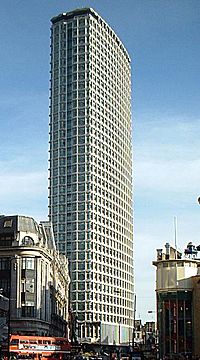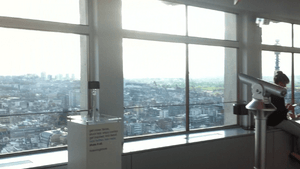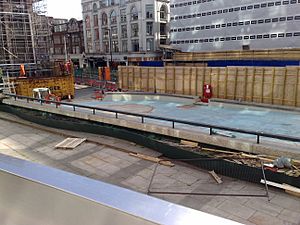Centre Point facts for kids
Quick facts for kids Centre Point |
|
|---|---|
 |
|
| General information | |
| Status | Complete |
| Type | Residential (converted from commercial) |
| Architectural style | Modernist |
| Address | New Oxford Street |
| Town or city | London, WC1 |
| Country | United Kingdom |
| Construction started | 1963 |
| Completed | 1966 |
| Renovated | 2016–18 |
| Height | 117m (385ft) |
| Technical details | |
| Structural system | Reinforced concrete |
| Floor count | 34 |
| Design and construction | |
| Architect | George Marsh |
| Architecture firm | R. Seifert and Partners |
| Structural engineer | Pell Frischmann |
| Main contractor | Wimpey Construction |
Centre Point is a very tall and famous building in Central London. It has a main tower with 34 floors. There is also a smaller block next to it with shops and offices. A connecting part joins the two sections. The building is located near Tottenham Court Road tube station. This is a very busy area of London.
The building is 117 meters (385 feet) high. It has 34 floors and a lot of space inside. It was built between 1963 and 1966. Centre Point was one of the first skyscrapers in London. For many years, it stood empty after it was finished. This caused a lot of discussion. In 1995, it became a Grade II listed building. This means it is a special building that must be protected. Later, in 2015, it was changed from offices into fancy apartments.
Contents
Building Centre Point: A Look Back
How Centre Point Was Built
The building was designed by an architect named George Marsh. His company was called R. Seifert and Partners. Engineers from Pell Frischmann also helped. The construction company Wimpey Construction built it. This happened from 1963 to 1966. The cost was about £5.5 million. Special concrete pieces were made in Dorset. They were then brought to London by trucks.
Why Centre Point Stayed Empty
Centre Point was built by a rich property owner named Harry Hyams. He wanted to rent the entire building to just one big company. He hoped to get a very high price for it. Because of this, the building stayed empty for many years. People started calling it "London's Empty Skyscraper." Property prices were going up. So, Mr. Hyams could wait for his perfect tenant. He did not want to rent out single floors.
Centre Point and Helping the Homeless
The building's emptiness caused a lot of anger. Many people in London needed homes. In 1969, a charity called Centrepoint was started. It helps young homeless people. The charity was named after the empty Centre Point building. It showed how unfair it was to have a huge empty building when people had nowhere to live.
In 1974, some housing activists decided to take action. They temporarily moved into Centre Point for a weekend. This was to show everyone that the building was empty. They wanted to highlight the housing problems in London.
Later Life of the Building
From 1980 to 2014, Centre Point was the main office for the Confederation of British Industry (CBI). This group represents businesses in the UK. They were the longest-running tenants in the building.
In 2005, a company called Targetfollow bought Centre Point. They paid £85 million for it. The building was then updated. Some companies that rented space there included William Morris, Saudi Aramco, and EA Games.
Later, another company, Almacantar, bought the building. They decided to change it from offices into homes. The work to turn it into luxury apartments finished in 2018. However, even after the change, many of the new apartments remained empty. This has led some to call it one of London's "ghost towers."
Changes Around Centre Point
When Centre Point was first built, there were plans for better transport links. There were also plans for new roads. But these plans were not fully completed. The pedestrian subway near the building caused some problems.
In 2006, experts said the area around Centre Point was not well designed. They noted that the narrow sidewalks pushed people into the bus lanes. This led to many pedestrian accidents. Now, with the new Tottenham Court Road Underground Station being built, the area is changing. The traffic island beneath Centre Point is being turned into an open public space. This will make the area much safer and nicer for people walking by.



